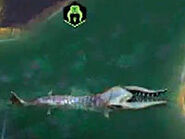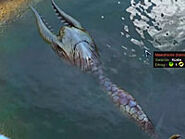| Sea Dragon | |
|---|---|
 Alien Melee Sea Unit in Beyond Earth | |
| Moves | |
| Base Unit Strength | |
Sea Dragon
 Movement: 2
Movement: 2 Strength: 16
Strength: 16
Game Info[]
Basic alien naval unit.
Strategy[]
The Sea Dragon appears noticeably more aggressive than some of the other Aliens present in the game. It is common for them to approach and attack your naval (or embarked) units, even if you have never had any hostile encounters with the aliens.
It is advised to escort embarked units with gunboats early game, due to the aggressive nature of Sea Dragons.
Civilopedia entry
Serpentis Maris Ingentes
Legends of Old Earth populated the seas with monsters, serpents and all manner of fearsome beasts; mariners’ tales were often of creatures as yet unverified by science: sperm whales, giant squids, great white sharks, dolphins and the like. But this planet indeed has a sea monster: Serpentis Maris Ingentes, better known as the “sea dragon.” Zoologists have not yet classified this creature, for it has characteristics of both Earth Ophidia and Cephalopoda classes. Scientists have speculated that it is an oceanic evolution of the Vermis Obsidione Collossus, but that hypothesis remains a matter of intense debate.
A massive creature, the largest specimen found thus far measures slightly under 200 meters, yet weighed only 1275 kg, indicating that its natural habitat is in deep water – although it can survive for lengthy periods at shallower depths. Broad fins along the mantle provide locomotion, combined with an undulating contraction of symmetrical lateral muscles. Like the drillworm, it has a trifurcated mouth lined with hooks. While the primary staple of its diet is the planetary equivalent of krill, it too will eat almost any organic matter. The keenness of its sight is a matter of conjecture; it has been observed that its can focus its trinocular vision upon a single point. In addition, like some pit vipers on Earth, it has infrared-sensitive organs in the snout allowing it to track heat sources.
The latter means that it is drawn to ocean vessels, as it is unable to distinguish between organic and manufactured heat sources. This has led to a number of unfortunate encounters with colonial boats and ships, for Serpentis Maris has unexpectedly “attacked” such occasionally. In general, however, the species is not aggressive, and the greatest danger to shipping, swimmers and human aquaculture are inadvertent collisions. On the other hand, the flesh of the Serpentis Maris has proved to be a delicacy and hunting, similar to the outlawed whaling industry, these beasts have become a profitable pursuit in some settlements, leading to ever more violent encounters.




